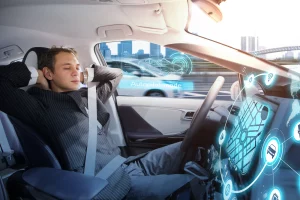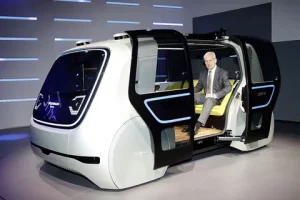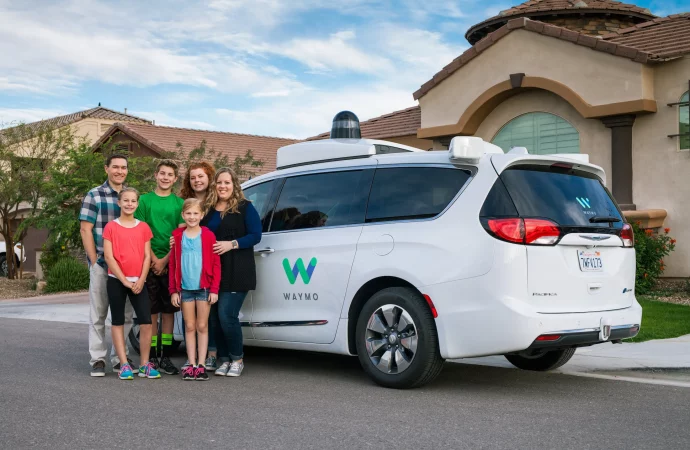Recent years have seen a tremendous advancement in automated vehicle technology, which holds promise for a large reduction in human error—which accounts for approximately 94% of crashes. With driver assistance technologies significantly improving road safety, the transition to fully automated driving systems is already under way. Automated cars have the potential to completely transform roads
Recent years have seen a tremendous advancement in automated vehicle technology, which holds promise for a large reduction in human error—which accounts for approximately 94% of crashes. With driver assistance technologies significantly improving road safety, the transition to fully automated driving systems is already under way. Automated cars have the potential to completely transform roads in a number of ways, including preventing collisions and enhancing accessibility and environmental sustainability. The development, advantages, and applications of automated safety systems are examined in this article, along with the National Highway Traffic Safety Administration’s (NHTSA) initiatives to increase everyone’s driving safety.
Evolution of Safety Technologies in Vehicles

Image by Yandex.com
Every ten years, there has been a notable advancement in automotive safety technology. Basic safety and convenience were offered in the early years (1950–2000) with equipment like cruise control, seat belts, and antilock brakes. As the 2000s went on, proactive safety measures began to be improved by technologies like lane departure warnings, electronic stability control, and blind-spot recognition.
More sophisticated driver assistance systems were included during the 2010s. In order to prevent possible collisions, rearview video systems, automated emergency braking, and pedestrian recognition were crucial. We are getting closer to a completely automated future where cars handle the majority of driving duties as a result of these developments, which are already developing into partially automated features like adaptive cruise control and traffic jam assist.
Key Automated Safety Features Today
Modern automated safety features are transforming how vehicles respond to potential dangers, many of which fall under Advanced Driver Assistance Systems (ADAS) and Automated Driving Systems (ADS). Here are some critical technologies in use today:
- Lane Keeping Assist: Helps drivers stay within lane boundaries by providing warnings or corrective actions.
- Adaptive Cruise Control: Adjusts vehicle speed to maintain a safe following distance.
- Traffic Jam Assist: Manages speed in stop-and-go traffic, reducing driver strain.
- Automatic Emergency Braking: Detects potential collisions and automatically brakes if the driver doesn’t respond.
- Pedestrian Automatic Emergency Braking: Specialized braking system that detects pedestrians in a vehicle’s path.
- Rear Cross Traffic Alert: Warns drivers of oncoming vehicles while reversing.
These features not only improve driver safety but also protect passengers, bicyclists, and pedestrians, contributing to a safer environment for everyone on the road.
Benefits of Automated Driving Systems
Automated driving systems promise numerous benefits that extend beyond individual driver safety. Here are some of the critical advantages:
Enhanced Safety and Crash Reduction:
Automated vehicles are designed to anticipate and respond faster to dangerous situations than human drivers. For instance, an ADAS can detect an imminent crash and take action before the driver even realizes it. This reduces human error and can prevent countless road incidents.
Increased Accessibility:
Automated driving systems have the potential to enhance mobility for seniors and individuals with disabilities, who may otherwise face challenges in traditional driving. These technologies open new opportunities for independence and ease of transport for underrepresented communities.
Environmental Impact:
Automated vehicle technology often pairs with electrification, leading to greener transportation. As automated ride-sharing fleets increase, the need for personal vehicle ownership could reduce, easing the demand for parking lots and reducing emissions from traffic congestion.
Economic Benefits:
The economic burden of crashes is significant, costing billions in damages and medical expenses. Reducing crashes through automation can alleviate this financial impact, making roads not only safer but also economically sustainable.
Traffic Efficiency:
With traffic delays costing Americans an estimated 6.9 billion hours in 2014, automation could alleviate this issue. Automated systems can optimize traffic flow, reduce delays, and ensure better fuel efficiency, allowing drivers more time with family and less stress on the road.
Examples of Automated Safety Systems in Use
Real-world applications demonstrate how automated safety features enhance driver and passenger security:
- Tesla’s Autopilot: Offers lane-keeping, adaptive cruise control, and collision warning, providing semi-automated assistance on highways. While it requires driver supervision, Tesla’s features have been credited with reducing accidents in specific conditions.
- Ford Co-Pilot360: Includes features like blind-spot monitoring, pre-collision assist, and lane-keeping systems, designed to help drivers navigate roads safely with additional support.
- Waymo’s Self-Driving Vehicles: Although still in the testing phase, Waymo’s automated driving technology offers a glimpse into the future of full automation. These vehicles have logged millions of miles in cities across the U.S., focusing on safety and data collection to improve reliability.
Challenges in Automated Vehicle Adoption

Image by Yandex.com
Despite the clear advantages, the journey to full automation is not without hurdles:
- Safety Testing and Regulation: Automated systems undergo rigorous testing to ensure they operate safely. The NHTSA oversees these processes, requiring companies to meet Federal Motor Vehicle Safety Standards. However, regulatory frameworks must continue evolving to address the unique challenges of self-driving technologies.
- Cybersecurity Concerns: Automated vehicles rely on an extensive network of sensors and computing power, making them vulnerable to cyberattacks. Ensuring that these systems are secure is a top priority for developers and regulators alike.
- Liability and Insurance: Determining liability in case of an accident involving an automated vehicle is complex. As driving responsibilities shift from human to machine, policymakers and insurance companies need to redefine accountability in case of system malfunctions or errors.
NHTSA’s Role and Standards in Ensuring Safety
The NHTSA plays a central role in guiding the safe development and implementation of automated driving systems. Key NHTSA initiatives include:
- AV TEST Initiative: Allows states and companies to report automated vehicle testing data to the public. This transparency helps build public trust and provides insights into the technology’s development.
- Federal Automated Vehicles Policy: Established in 2016, this policy sets safety standards for automated vehicles, ensuring that companies prioritize safe operations as they innovate.
- Safety General Order: In 2021, the NHTSA mandated that manufacturers report crashes involving automated driving systems, ensuring accountability and providing data for safer implementations in the future.
Through these policies, the NHTSA aims to maintain a balanced approach to regulation, allowing for innovation while prioritizing public safety.
The Future of Fully Automated Safety Features

Image by Yandex.com
As automated driving technology matures, vehicles with higher levels of automation are expected to reach consumers. These future advancements include:
- Level 4 and Level 5 Automation: Higher levels of automation will enable vehicles to handle most or all driving tasks without human intervention. Such systems could drastically reduce the need for human involvement, further minimizing human error-related accidents.
- Equity in Transportation: Automated vehicles could address accessibility challenges by offering tailored features for people with disabilities and those who lack access to traditional transportation.
- Reduction in Environmental Impact: As vehicles transition to automated and electric systems, emissions could decrease, leading to cleaner air and better urban planning, with fewer resources required for parking spaces.
The technology has the potential to enhance not only safety but also the broader transportation ecosystem, transforming how people navigate and interact with their environment.
Final Thought
There is revolutionary potential for safety, mobility, and environmental sustainability as we move toward fully automated vehicles. Today’s cars already demonstrate the ability of automation to avert collisions and save lives with features like automated braking, adaptive cruise control, and lane-keeping assistance. The future of automated vehicles may redefine road safety as long as the NHTSA continues to play a crucial role in ensuring their safe development and implementation.
In the end, there are still issues with cybersecurity, legislation, and public trust, but there is no denying the safety advantages of driverless cars. In addition to making roads safer for both pedestrians and drivers, automated cars also promise to increase mobility, lower environmental effects, and provide new efficiencies. These developments will make driving safer, cleaner, and more accessible to everybody.
















